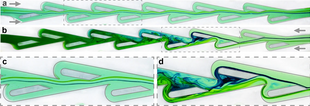
Back Vàlvula de Tesla Catalan Tesla-ventil Danish Teslaventil German Válvula de Tesla Spanish دریچه تسلا Persian Ventiel van Tesla Dutch Válvula de Tesla Portuguese Клапан Теслы Russian Tesla vanası Turkish Клапан Тесли Ukrainian


(a) Forward direction. Two adjacent filaments remain in the central corridor of the conduit with only small lateral deflections.
(b) Reverse direction. The filaments ricochet off the periodic structures, deflecting increasingly sharply before being rerouted around the 'islands' and mixing.
(c) and (d) are zoomed-in images
A Tesla valve, called a valvular conduit by its inventor, is a fixed-geometry passive check valve. It allows a fluid to flow preferentially in one direction, without moving parts. The device is named after Nikola Tesla, who was awarded U.S. patent 1,329,559 in 1920 for its invention. The patent application describes the invention as follows:[1]
The interior of the conduit is provided with enlargements, recesses, projections, baffles, or buckets which, while offering virtually no resistance to the passage of the fluid in one direction, other than surface friction, constitute an almost impassable barrier to its flow in the opposite direction.
Tesla illustrated this with the drawing, showing one possible construction with a series of eleven flow-control segments, although any other number of such segments could be used as desired to increase or decrease the flow regulation effect.
© MMXXIII Rich X Search. We shall prevail. All rights reserved. Rich X Search